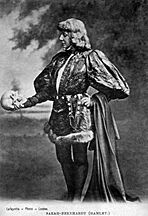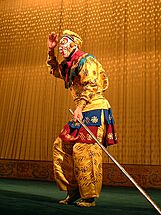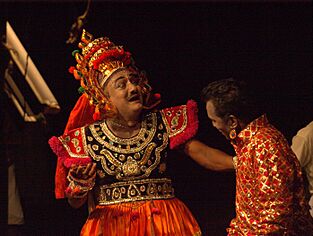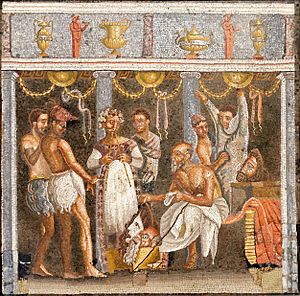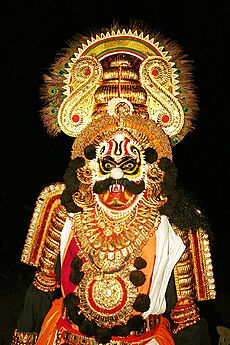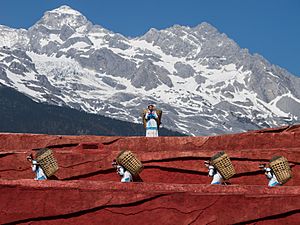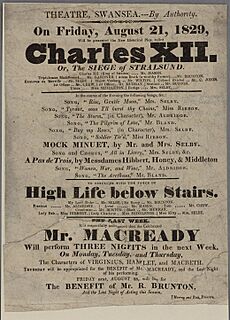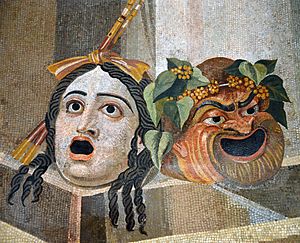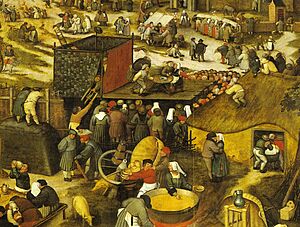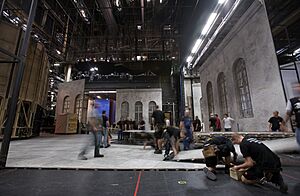Theatre facts for kids
- Sarah Bernhardt as Hamlet in 1899.
- Sun Wukong from Journey to the West at the Peking opera.
- Koothu, an old Indian performing art from Tamilakam.
Theatre is a special kind of live show where performers, usually actors, act out a real or made-up story for an audience. They do this in a specific place, often on a stage. Actors can share the story using body language, talking, singing, music, and dance. Theatre is the oldest way to tell stories through acting, even though we now have movies and TV shows.
Things like painted backgrounds and special lighting help make the show feel more real and exciting. The buildings where these shows happen are also called "theatres." The word comes from an Ancient Greek word meaning "a place for viewing."
A theatre company is a group that creates theatre shows. This is different from an acting group, which is just the performers working together.
Today's theatre includes plays and musical theatre. Even ballet and opera are types of theatre. They use acting, costumes, and staging, and helped musicals become what they are today.
Contents
A Look at Theatre History
Ancient Greek Theatre
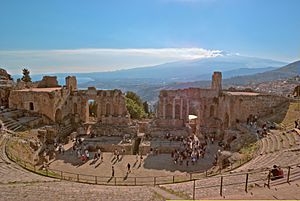
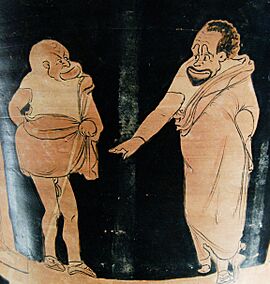
Western theatre started in the city of Athens, Greece. It was a big part of their culture, including festivals, religious events, and even law and politics.
Being part of the city's many festivals was important for citizens. This included going to the City Dionysia, a big theatre festival. The Greeks also came up with ideas for how to judge plays and how to design theatre buildings. Actors were not always professionals back then.
Ancient Greek theatre had three main types of plays: tragedy, comedy, and the satyr play.
Aristotle, a famous thinker from 384–322 BCE, said that Greek theatre began at festivals honoring Dionysus, the god of wine. Shows were held in large, half-circle outdoor theatres built into hillsides. These could hold 10,000 to 20,000 people! The stage had a dancing area and a changing room. Since the words were key, good sound was very important. Actors (always men) wore masks for their characters and might play many roles.
Athenian tragedy is the oldest type of tragedy we still have. It was a kind of dance-drama that became popular in the 5th century BCE. Only 32 of the more than a thousand tragedies from that time have survived. We have full plays by Aeschylus, Sophocles, and Euripides. Tragedies were part of contests at festivals for Dionysus. Playwrights had to present four plays: three tragedies and one satyr play.
Most Greek tragedies told stories from Greek mythology. But The Persians by Aeschylus was different. It showed the Persian reaction to losing a battle in 480 BCE. Aristotle later studied these plays in his book Poetics around 335 BCE.
Greek comedy is split into "Old Comedy," "Middle Comedy," and "New Comedy." Old Comedy is mostly known through the plays of Aristophanes. Middle Comedy is mostly lost, and New Comedy is known from Menander. Aristotle said comedy shows funny people who make mistakes but don't cause real pain or disaster.
Besides comedy and tragedy, the City Dionysia also had the Satyr Play. These plays were like a mix of tragedy and comedy, often with a silly, playful tone. They usually involved the Greek gods and a group of Satyrs, who were mischievous forest creatures.
Roman Theatre
Theatre grew a lot under the Romans. A Roman historian named Livy wrote that Romans first saw theatre in the 4th century BCE. Roman theatre was lively and varied. It included street theatre, dancing, and acrobatics at festivals. There were also funny plays by Plautus and serious tragedies by Seneca.
The Romans were influenced by Greek culture in the 3rd century BCE. This helped Roman theatre develop high-quality plays in Latin. The only Roman plays we still have are ten dramas by Seneca.
Indian Theatre
The first type of Indian theatre was Sanskrit theatre. The oldest parts of it we have are from the 1st century CE. It started after Greek and Roman theatre but before theatre in other parts of Asia. It was popular between the 1st and 10th centuries CE, a peaceful time when many plays were written.
A main source of information about Sanskrit theatre is A Treatise on Theatre. This book, written around 200 BCE to 200 CE, is the most complete work on drama from the ancient world. It talks about acting, dance, music, how plays are built, theatre buildings, costumes, makeup, props, and how theatre companies worked. It even tells a mythological story about how theatre began.
Sanskrit theatre was performed in sacred places by priests who were trained in dance, music, and speaking. Its goal was to teach and to entertain.
Performers worked in professional groups led by a stage manager. They were trained very well in how to use their voices and bodies. Women were allowed to perform, and there were all-male, all-female, and mixed groups. Some feelings were thought to be better shown by women. Performers played characters of their own age or different ages. The Treatise focuses most on acting, which had realistic and traditional styles.
Sanskrit drama is seen as a great achievement in Sanskrit literature. It used common characters like the hero, heroine, or clown. Actors might specialize in one type of character. Kālidāsa, from the 1st century BCE, is thought to be ancient India's greatest Sanskrit writer. His famous romantic plays include Mālavikāgnimitram, Vikramuurvashiiya, and Abhijñānaśākuntala. The last one was inspired by a story in the Mahabharata and was the first to be translated into English and German. It even influenced Goethe's Faust.
Another great Indian writer was Bhavabhuti (around 7th century CE). He wrote three plays, two of which cover the epic story of Ramayana. The powerful emperor Harsha (606–648) is also said to have written three plays, including a comedy and a Buddhist drama.
East Asian Theatre
The Tang dynasty (618–907 CE) in China is sometimes called "The Age of 1000 Entertainments." During this time, Emperor Ming Huang started an acting school called The Pear Garden. This school focused on musical drama, which is why actors are sometimes called "Children of the Pear Garden."
During the Tang dynasty, shadow puppetry also became a known form of theatre in China. There were two main types: Pekingese (northern) and Cantonese (southern). They differed in how the puppets were made and how the control rods were attached. Both styles usually told stories of adventure and fantasy.
Cantonese shadow puppets were larger and made of thick leather, making bigger shadows. Colors were symbolic: black faces meant honesty, red meant bravery. The rods were attached to the puppets' heads so they wouldn't be seen. Pekingese puppets were smaller and more delicate. They were made from thin, see-through leather and painted with bright colors, casting colorful shadows. Their rods were attached to the neck and ran parallel to the body. This allowed different heads to be used with one body. Puppeteers would remove the heads at night because of an old belief that puppets would come to life if left whole.
Shadow puppetry was at its artistic peak in the 11th century before it was sometimes used by the government.
In the Song dynasty (960–1279 CE), there were popular plays with acrobatics and music. These grew into a more complex form called zaju in the Yuan dynasty (1271–1368 CE), which had four or five acts. Yuan drama spread across China and led to many regional styles, like Peking Opera, which is still popular today.
Xiangsheng is a traditional Chinese comedy act, either a solo talk or a conversation between two people.
Japanese theatre forms like Kabuki, Nō, and Kyōgen developed in the 17th century CE.
Indonesian Theatre
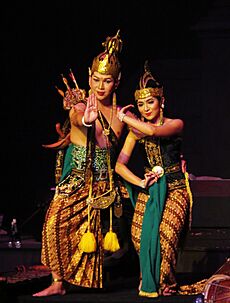
In Indonesia, theatre has been a key part of local culture for thousands of years. Most of Indonesia's oldest theatre forms are connected to local stories. The famous puppet theatres, like wayang golek (wooden rod puppets) and wayang kulit (leather shadow puppets), often tell stories from the Ramayana and Mahabharata. These tales also inspire wayang wong (human theatre) in Java and Bali, which uses actors. Some wayang golek shows also tell Muslim stories.
Wayang is an ancient way of storytelling known for its detailed puppets and complex music. The earliest records of wayang are from the 9th century. An old Javanese writing from around 840 AD mentions three types of performers: atapukan (mask dance), aringgit (wayang puppet show), and abanwal (joke art).
Medieval Islamic Theatre
Theatre in the medieval Islamic world included puppet theatre (with hand puppets, shadow plays, and marionettes). There were also live plays called ta'ziyeh, where actors re-enacted events from Muslim history. These plays often focused on the death of Ali's sons, Hasan ibn Ali and Husayn ibn Ali. Other plays, called akhraja, were less common.
Early Modern and Modern Western Theatre

Between the 15th and 19th centuries, Western theatre took on many forms. These included commedia dell'arte from Italian theatre and melodrama. Plays generally moved away from poetic language towards more natural, everyday speech, especially after the Industrial Revolution.
Theatre in England stopped almost completely between 1642 and 1660. This was because of the Puritans, who thought theatre was sinful. They ordered London theatres to close in 1642. Actors protested, but the ban stayed. This quiet period ended when Charles II became king again in 1660. Theatre, and other arts, then grew quickly, influenced by French culture because Charles had lived in France.
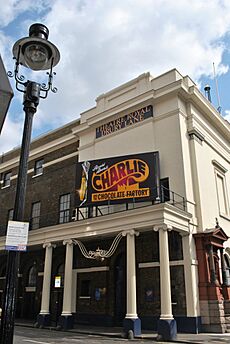
In 1660, two theatre companies were allowed to perform. Shows were held in buildings like tennis courts that were changed into theatres. The first West End theatre, Theatre Royal in Covent Garden, was built in London.
Theatre buildings changed a lot. Instead of round theatres like the Globe Theatre, new ones had a stage at the front and seats facing it. This meant some seats were much better than others. The king would have the best seat, right in the middle, to see the stage perfectly. Philippe Jacques de Loutherbourg was an important set designer who used space and scenery well.
There was still debate about what should be shown on stage. A preacher named Jeremy Collier wrote a strong attack on theatre. People who didn't go to the theatre, and very religious people, wondered if seeing bad things on stage would make people act badly in real life. This debate still happens today.
The 17th century also brought women to the stage, which was new and exciting. These women became famous, but some people still thought it was not proper for ladies to act. King Charles II wanted women to play female roles instead of young men. Because women were allowed to act, playwrights could create new plot twists, like women dressing as men for funny escapes.
Comedies often featured young, fashionable people and their love lives. Many were like French comedies, especially those by Molière. He changed how comedy was written and performed by mixing Italian commedia dell'arte with French styles. Tragedies often focused on political power, which was important after the king returned. English tragedies sometimes mixed in funny parts, unlike French ones. Plays about everyday life and its problems became popular in England.
In the 18th century, the idea of a national theatre gained support. This meant having a main theatre for a country. Abel Seyler was a big supporter of this idea in Germany.
Through the 19th century, popular theatre forms like Romanticism, melodrama, and Victorian burlesque changed. They led to plays that showed real life, like those by Henrik Ibsen. Musical theatre also grew, with famous works like those by Gilbert and Sullivan.
These trends continued into the 20th century. We saw realistic acting styles from Konstantin Stanislavski, political theatre from Bertolt Brecht, and the strange "Theatre of the Absurd" from writers like Samuel Beckett. American and British musicals became very popular. There were also experimental and modern theatre styles, and theatre that focused on social change.
Different Kinds of Theatre
Drama
Drama is a type of story told through performance. The word comes from a Greek word meaning "action." When actors perform a drama on a stage for an audience, it takes teamwork. The way drama is written is shaped by this teamwork and by the audience watching it. Famous dramas include Hamlet by William Shakespeare and Oedipus Rex by Sophocles. A modern example is Long Day's Journey into Night.
Drama is often mixed with music and dance. In opera, the story is sung. Musicals have both talking and songs. Some dramas have background music. In improvisation, the actors make up the story as they perform it, right in front of the audience.
Musical Theatre

Music and theatre have always been close. Ancient Greek tragedies, for example, had a chorus that sang. Modern musical theatre combines music, talking, and dance. It grew from funny operas and variety shows in the late 19th and early 20th centuries.
After early musicals, Oklahoma! in 1943 made musicals more dramatic. Famous musicals since then include My Fair Lady, West Side Story, Les Misérables, Cats, The Phantom of the Opera, and newer hits like Hamilton and Frozen.
Musicals can be small, but often they are grand shows. Broadway and West End musicals often have amazing costumes and sets, costing millions of dollars.
Comedy
Theatre shows that use humor to tell a story are called comedies. This can be a modern funny play or a classic like As You Like It. When a play deals with serious or difficult topics in a funny way, it's called black comedy. Black comedy can include silly humor or dark, sarcastic jokes.
Tragedy
Tragedy is a specific type of drama that has been very important in Western culture. It started in Athens over 2,500 years ago. Only a few plays from writers like Aeschylus, Sophocles, and Euripides still exist. Later, famous tragedies were written by Shakespeare and others.
Aristotle described tragedy as showing a serious, complete action that uses beautiful language. It aims to make the audience feel pity and fear, which then helps them feel better. He said tragedy has six parts: plot, character, thought, words, song, and spectacle (what you see).
Tragedy has always been a place for new ideas and changes in culture. In modern times, tragedy is often compared to other types of plays like comedy, melodrama, and tragicomedy.
Improvisation
Improvisation, or making things up on the spot, has always been part of theatre. The Commedia dell'arte in the 16th century was one of the first forms of improv. Today, famous people like Dario Fo and groups like the Upright Citizens Brigade continue to make improv popular.
Keith Johnstone and Viola Spolin are seen as the first modern teachers of improvisation. Johnstone saw improv as a different way to do theatre, while Spolin used it to help actors develop skills or create funny situations. Spolin also thought about how learning improv could help people grow in general.
Spolin's son, Paul Sills, helped make improvisational theatre a popular art form when he started The Second City in Chicago.
How Theatre Works
Theatre has been a key part of human culture for over 2,500 years. It has many different ideas and ways of doing things. Some ideas are about politics or beliefs, while others are just about art. Some theatre focuses on a story, some on the event itself, and some on changing society.
The Greek philosopher Aristotle wrote the earliest book about theatre, Poetics, around 335 BCE. His ideas have influenced theatre ever since. He talked about what he called "poetry," which included all forms of drama. He looked at its main parts and identified its types and basic elements. His ideas about tragedy are a big part of his book.
Aristotle said tragedy has six important parts: plot, character, thought, words, song, and what you see. Many people have different ideas about his work. Important theatre artists of the 20th century include Konstantin Stanislavski, Bertolt Brecht, Peter Brook, and Augusto Boal.
Stanislavski saw theatre as its own art form, separate from literature. He believed the writer's part was just one piece of a team effort. His ideas about acting are still very important in Western theatre training today. Many actors use his basic ideas without even knowing it. His "system" of actor training became popular worldwide. It helps actors explore characters from the "inside out" (feelings) and the "outside in" (physical actions).
Behind the Scenes: Technical Aspects
Theatre needs teamwork to create a show and an audience to watch it. The way plays are written is directly affected by this teamwork and by the audience. Making a play usually involves a playwright (who writes it), a director, actors, and a technical team. This team includes designers for sets, lighting, costumes, and sound. It also has a stage manager and a technical director. Sometimes, there's also a composer, a dramaturg (who helps with the play's history and ideas), or a fight director.
Stagecraft is a general term for all the technical parts of making a show. This includes building and moving scenery, setting up lights, designing and getting costumes, doing makeup, finding props, managing the stage, and recording sound. Stagecraft is about making the designer's artistic ideas happen in a practical way.
In a small show, one person (often the stage manager) might handle everything. In big professional shows, like on Broadway, hundreds of skilled people work on stagecraft. This includes carpenters, painters, electricians, and costume makers. This modern stagecraft is very specialized. Most theatres fall somewhere in between, with a technical director and different designers for each area.
Types of Theatre Groups
There are many modern theatre groups that create shows in different ways. Theatre can be simple or very grand, with huge budgets. People involved can be beginners in community theatre or professionals on Broadway. This leads to many types of theatre:
- Broadway theatre and West End theatre (big, professional shows)
- Community theatre (local groups, often volunteers)
- Dinner theater (shows with a meal)
- Fringe theatre (smaller, often experimental shows)
- Immersive theater (audience is part of the show)
- Interactive theatre (audience can influence the show)
- Off-Broadway and Off West End (smaller professional theatres)
- Off-off-Broadway (very small, experimental theatres)
- Playback theatre (actors act out audience stories)
- Regional theatre (professional theatres outside major cities)
- Touring theatre (companies that travel with their shows)
- Site-specific theatre (shows made for a particular place)
- Street theatre (shows performed outdoors)
- Summer stock theatre (shows performed in summer, often in rural areas)
Repertory Companies
Most theatre companies practice one show, perform it for a while, and then start a new one. But repertory companies practice many shows at once. They can perform these different shows whenever needed and often perform them for years. Most dance companies work this way. The Royal National Theatre in London uses a repertory system.
Repertory theatre usually has a group of equally talented actors. It relies more on the group's reputation than on one famous actor. It also needs less strict control from a director because actors who have worked together a lot can respond to each other easily.
Other Theatre Words
A theatre company creates shows. A theatre troupe (or acting company) is just the group of actors working together.
A touring company is a theatre or dance group that travels, often around the world. They perform in different theatre buildings in each city.

To put on a show, you need a theatre company and a place to perform. When a theatre company is the only group performing in a building, that theatre is called a resident theatre or a producing theatre. This is because the theatre creates its own shows. Other theatre companies, and dance companies, that don't have their own building perform at rental theatres or presenting theatres. These theatres don't have full-time groups. They might have part-time groups or let other companies use their space. A rental theatre lets companies find the space, while a presenting theatre finds companies to show their work.
Some groups perform in places that aren't traditional theatres. These shows can be outside or inside, in unusual spaces. Examples include street theatre and site-specific theatre. Using non-traditional places can make the show feel more real or meaningful for the audience. These places can also be changed more easily or fit different equipment and sets.
Theatre Unions
There are many theatre unions that help protect the rights of people working in theatre:
- Actors' Equity Association (AEA), for actors and stage managers in the U.S.
- Canadian Actors' Equity Association, for actors in Canada.
- Equity, for many types of performers, designers, directors, and stage managers in the UK.
- International Alliance of Theatrical Stage Employees (IATSE), for designers and technicians.
- Media, Entertainment and Arts Alliance, an Australian union for actors, journalists, and entertainment workers.
- Stage Directors and Choreographers Society (SDC), for directors and choreographers.
See Also
 In Spanish: Teatro para niños
In Spanish: Teatro para niños
- Acting
- Black light theatre
- List of awards in theatre
- List of playwrights
- List of theatre personnel
- List of theatre festivals
- List of theatre directors
- Lists of theatres
- Performance art
- Puppetry
- Reader's theatre
- Site-specific theatre
- Theatre consultant
- Theatre for development
- Theater (structure)
- Theatre technique
- Theatrical style
- Theatrical troupe
- World Theatre Day


